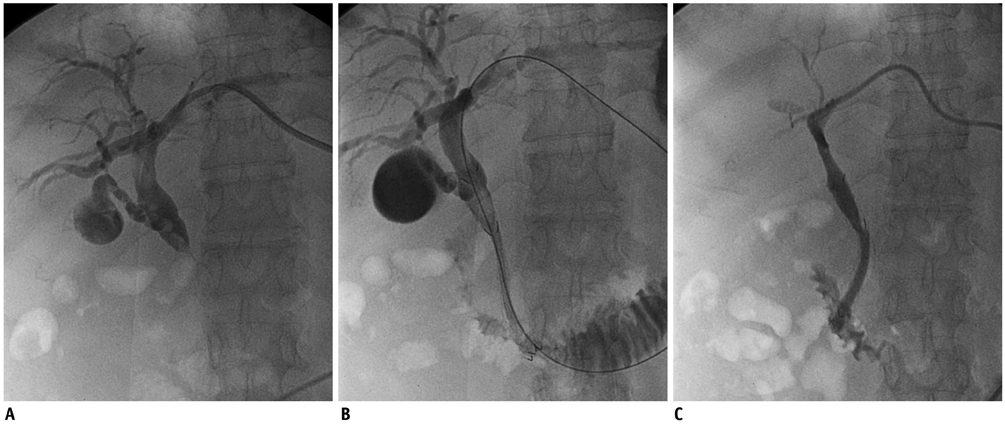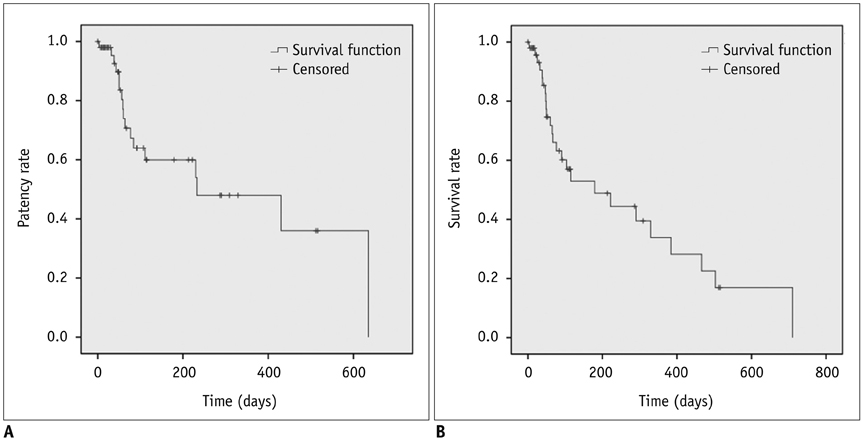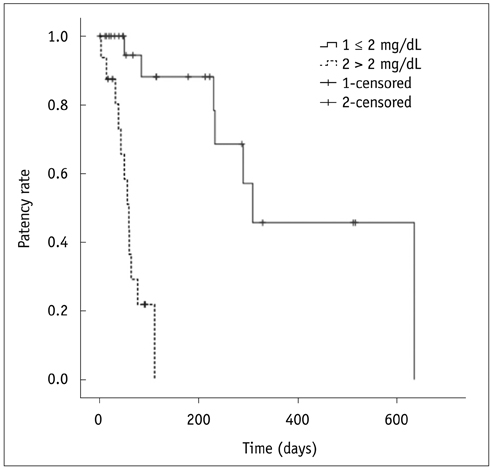Korean J Radiol.
2013 Oct;14(5):789-796. 10.3348/kjr.2013.14.5.789.
Percutaneous Placement of Self-Expandable Metallic Stents in Patients with Obstructive Jaundice Secondary to Metastatic Gastric Cancer after Gastrectomy
- Affiliations
-
- 1Department of Radiology, Kangbuk Samsung Hospital, Sungkyunkwan University School of Medicine, Seoul 110-746, Korea.
- 2Department of Radiology, Korea University Guro Hospital, Korea University College of Medicine, Seoul 152-703, Korea. g1q1papa@korea.ac.kr
- 3Department of Gastroenterologic Surgery, Korea University Guro Hospital, Korea University College of Medicine, Seoul 152-703, Korea.
- 4Department of Radiology, Kyung Hee University Medical Center, Seoul 130-872, Korea.
- 5Department of Radiology, Kangwon National University College of Medicine, Chuncheon 200-722, Korea.
- 6Division of Interventional Radiology, Mallinckrodt Institute of Radiology, Washington University School of Medicine, St. Louis, MO 63110, USA.
- KMID: 1711435
- DOI: http://doi.org/10.3348/kjr.2013.14.5.789
Abstract
OBJECTIVE
To evaluate the outcomes of patients undergoing percutaneous placements of a biliary stent for obstructive jaundice secondary to metastatic gastric cancer after gastrectomy.
MATERIALS AND METHODS
Fifty patients (mean age, 62.4 years; range, 27-86 years) who underwent percutaneous placements of a biliary stent for obstructive jaundice secondary to metastatic gastric cancer after gastrectomy were included. The technical success rate, clinical success rate, complication rate, stent patency, patient survival and factors associated with stent patency were being evaluated.
RESULTS
The median interval between the gastrectomy and stent placement was 23.1 months (range, 3.9-94.6 months). The 50 patients received a total of 65 stents without any major procedure-related complications. Technical success was achieved in all patients. The mean total serum bilirubin level, which had been 7.19 mg/dL +/- 6.8 before stent insertion, decreased to 4.58 mg/dL +/- 5.4 during the first week of follow-up (p < 0.001). Clinical success was achieved in 42 patients (84%). Percutaneous transhepatic biliary drainage catheters were removed from 45 patients (90%). Infectious complications were noted in two patients (4%), and stent malfunction occurred in seven patients (14%). The median stent patency was 233 +/- 99 days, and the median patient survival was 179 +/- 83 days. Total serum bilirubin level after stenting was an independent factor for stent patency (p = 0.009).
CONCLUSION
Percutaneous transhepatic placement of a biliary stent for obstructive jaundice secondary to metastatic gastric cancer after gastrectomy is a technically feasible and clinically effective palliative procedure.
Keyword
MeSH Terms
-
Adult
Aged
Aged, 80 and over
Bile Duct Neoplasms/complications/secondary/*surgery
Bile Ducts, Extrahepatic/*surgery
Female
Follow-Up Studies
Gastrectomy
Humans
Jaundice, Obstructive/diagnosis/etiology/*surgery
Male
Middle Aged
Prosthesis Design
Retrospective Studies
*Stents
Stomach Neoplasms/*complications/secondary/surgery
Treatment Outcome
Figure
Reference
-
1. Saif MW, Makrilia N, Zalonis A, Merikas M, Syrigos K. Gastric cancer in the elderly: an overview. Eur J Surg Oncol. 2010; 36:709–717.2. Papachristou D, Fortner JG. Biliary obstruction after gastrectomy for carcinoma of the stomach. Surg Gynecol Obstet. 1978; 147:401–404.3. Kim GE, Shin HS, Seong JS, Loh JJ, Suh CO, Lee JT, et al. The role of radiation treatment in management of extrahepatic biliary tract metastasis from gastric carcinoma. Int J Radiat Oncol Biol Phys. 1994; 28:711–717.4. Makino T, Fujitani K, Tsujinaka T, Hirao M, Kashiwazaki M, Nakamori S, et al. Role of percutaneous transhepatic biliary drainage in patients with obstructive jaundice caused by local recurrence of gastric cancer. Hepatogastroenterology. 2008; 55:54–57.5. Lo SS, Wu CW, Chi KH, Tseng HS, Shen KH, Hsieh MC, et al. Concomitant chemoradiation treatment in the management of patients with extrahepatic biliary tract recurrence of gastric carcinoma. Cancer. 2000; 89:29–34.6. Chu KM, Law S, Branicki FJ, Wong J. Extrahepatic biliary obstruction by metastatic gastric carcinoma. J Clin Gastroenterol. 1998; 27:63–66.7. Laméris JS, Stoker J, Nijs HG, Zonderland HM, Terpstra OT, van Blankenstein M, et al. Malignant biliary obstruction: percutaneous use of self-expandable stents. Radiology. 1991; 179:703–707.8. Stoker J, Laméris JS, van Blankenstein M. Percutaneous metallic self-expandable endoprostheses in malignant hilar biliary obstruction. Gastrointest Endosc. 1993; 39:43–49.9. Rossi P, Bezzi M, Rossi M, Adam A, Chetty N, Roddie ME, et al. Metallic stents in malignant biliary obstruction: results of a multicenter European study of 240 patients. J Vasc Interv Radiol. 1994; 5:279–285.10. Lee BH, Choe DH, Lee JH, Kim KH, Chin SY. Metallic stents in malignant biliary obstruction: prospective long-term clinical results. AJR Am J Roentgenol. 1997; 168:741–745.11. Ho CS, Warkentin AE. Evidence-based decompression in malignant biliary obstruction. Korean J Radiol. 2012; 13:Suppl 1. S56–S61.12. Migita K, Watanabe A, Yoshioka T, Kinoshita S, Ohyama T. Clinical outcome of malignant biliary obstruction caused by metastatic gastric cancer. World J Surg. 2009; 33:2396–2402.13. Gwon DI, Ko GY, Sung KB, Yoon HK, Kim KA, Kim YJ, et al. Clinical outcomes after percutaneous biliary interventions in patients with malignant biliary obstruction caused by metastatic gastric cancer. Acta Radiol. 2012; 53:422–429.14. Weinstein JB, Heiken JP, Lee JK, DiSantis DJ, Balfe DM, Weyman PJ, et al. High resolution CT of the porta hepatis and hepatoduodenal ligament. Radiographics. 1986; 6:55–74.15. Lee BH, Chin SY, Kim SA, Kim KH, Do YS. Obstructive jaundice in gastric carcinoma: cause, site, and relationship to the primary lesion. Abdom Imaging. 1995; 20:307–311.16. Burke DR, Lewis CA, Cardella JF, Citron SJ, Drooz AT, Haskal ZJ, et al. Quality improvement guidelines for percutaneous transhepatic cholangiography and biliary drainage. Society of Cardiovascular and Interventional Radiology. J Vasc Interv Radiol. 1997; 8:677–681.17. Kubota Y, Nakatani S, Nakahashi Y, Takaoka M, Kin H, Inoue K. Bilateral internal biliary drainage of hilar cholangiocarcinoma with modified Gianturco Z stents inserted via a single percutaneous tract. J Vasc Interv Radiol. 1993; 4:605–610.18. Kim CW, Park AW, Won JW, Kim S, Lee JW, Lee SH. T-configured dual stent placement in malignant biliary hilar duct obstructions with a newly designed stent. J Vasc Interv Radiol. 2004; 15:713–717.19. Bang BW, Jeong S, Lee DH, Kim CH, Cho SG, Jeon YS. Curved planar reformatted images of MDCT for differentiation of biliary stent occlusion in patients with malignant biliary obstruction. AJR Am J Roentgenol. 2010; 194:1509–1514.20. Han YM, Kwak HS, Jin GY, Lee SO, Chung GH. Treatment of malignant biliary obstruction with a PTFE-covered self-expandable nitinol stent. Korean J Radiol. 2007; 8:410–417.21. Hong HP, Kim SK, Seo TS. Percutaneous metallic stents in patients with obstructive jaundice due to hepatocellular carcinoma. J Vasc Interv Radiol. 2008; 19:748–754.22. Saad WE, Wallace MJ, Wojak JC, Kundu S, Cardella JF. Quality improvement guidelines for percutaneous transhepatic cholangiography, biliary drainage, and percutaneous cholecystostomy. J Vasc Interv Radiol. 2010; 21:789–795.23. Kopelson G, Chu AM, Doucette JA, Gunderson LL. Extrahepatic biliary tract metastases from breast cancer. Int J Radiat Oncol Biol Phys. 1980; 6:497–504.24. Andersen JR, Sørensen SM, Kruse A, Rokkjaer M, Matzen P. Randomised trial of endoscopic endoprosthesis versus operative bypass in malignant obstructive jaundice. Gut. 1989; 30:1132–1135.25. Smith AC, Dowsett JF, Russell RC, Hatfield AR, Cotton PB. Randomised trial of endoscopic stenting versus surgical bypass in malignant low bileduct obstruction. Lancet. 1994; 344:1655–1660.26. Hintze RE, Adler A, Veltzke W, Abou-Rebyeh H. Endoscopic access to the papilla of Vater for endoscopic retrograde cholangiopancreatography in patients with billroth II or Roux-en-Y gastrojejunostomy. Endoscopy. 1997; 29:69–73.27. Swarnkar K, Stamatakis JD, Young WT. Diagnostic and therapeutic endoscopic retrograde cholangiopancreaticography after Billroth II gastrectomy--safe provision in a district general hospital. Ann R Coll Surg Engl. 2005; 87:274–276.28. Mueller PR, van Sonnenberg E, Ferrucci JT Jr. Percutaneous biliary drainage: technical and catheter-related problems in 200 procedures. AJR Am J Roentgenol. 1982; 138:17–23.29. Inal M, Akgül E, Aksungur E, Seydaogğlu G. Percutaneous placement of biliary metallic stents in patients with malignant hilar obstruction: unilobar versus bilobar drainage. J Vasc Interv Radiol. 2003; 14:1409–1416.30. van Delden OM, Laméris JS. Percutaneous drainage and stenting for palliation of malignant bile duct obstruction. Eur Radiol. 2008; 18:448–456.31. Kida M, Miyazawa S, Iwai T, Ikeda H, Takezawa M, Kikuchi H, et al. Recent advances of biliary stent management. Korean J Radiol. 2012; 13:Suppl 1. S62–S66.32. Inal M, Akgül E, Aksungur E, Demiryürek H, Yagğmur O. Percutaneous self-expandable uncovered metallic stents in malignant biliary obstruction. Complications, follow-up and reintervention in 154 patients. Acta Radiol. 2003; 44:139–146.33. Brountzos EN, Ptochis N, Panagiotou I, Malagari K, Tzavara C, Kelekis D. A survival analysis of patients with malignant biliary strictures treated by percutaneous metallic stenting. Cardiovasc Intervent Radiol. 2007; 30:66–73.
- Full Text Links
- Actions
-
Cited
- CITED
-
- Close
- Share
- Similar articles
-
- Percutaneous placement of self-expandable metallic stents in patients with obstructive jaundice due to hepatocellular carcinoma
- Metallic EndoCoilTM Stent Application for Patients with Malignant Obstructive Jaundice
- Malignant Obstructive Jaundice Following Gastrectomy for Gastric Carcinoma
- Self-expandable metal stent placement for recurrent cancer in a surgically-altered stomach
- A Case of Stenotic Change from Gastric Candidiasis Managed with Temporary Stent Insertion




